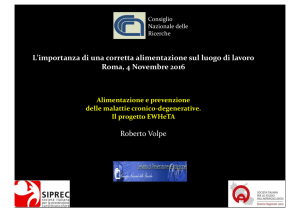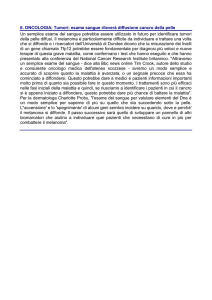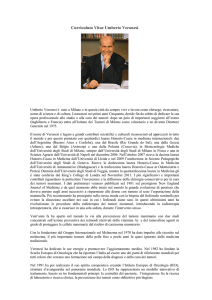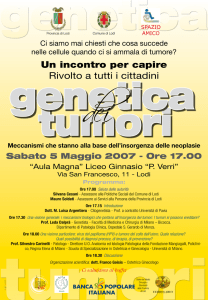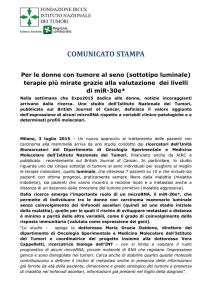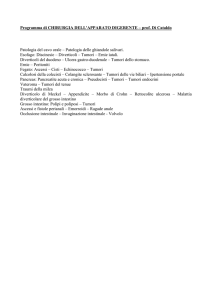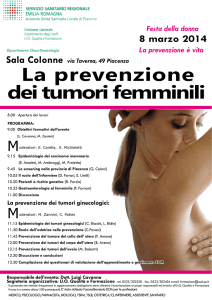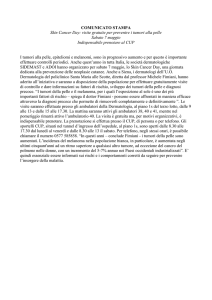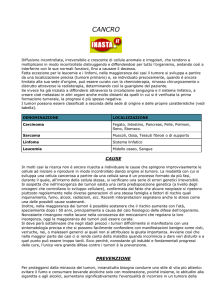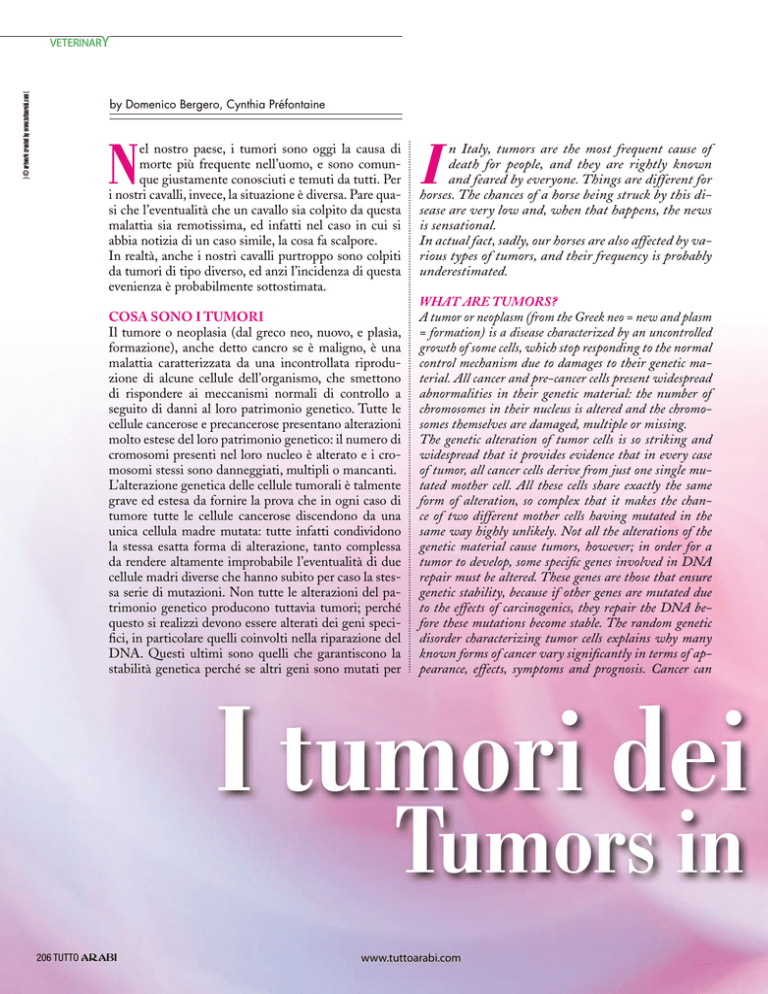
) © artwork created by www.tuttoarabi.com (
VETERINARY
by Domenico Bergero, Cynthia Préfontaine
N
el nostro paese, i tumori sono oggi la causa di
morte più frequente nell’uomo, e sono comunque giustamente conosciuti e temuti da tutti. Per
i nostri cavalli, invece, la situazione è diversa. Pare quasi che l’eventualità che un cavallo sia colpito da questa
malattia sia remotissima, ed infatti nel caso in cui si
abbia notizia di un caso simile, la cosa fa scalpore.
In realtà, anche i nostri cavalli purtroppo sono colpiti
da tumori di tipo diverso, ed anzi l’incidenza di questa
evenienza è probabilmente sottostimata.
Cosa sono i tumori
Il tumore o neoplasia (dal greco neo, nuovo, e plasìa,
formazione), anche detto cancro se è maligno, è una
malattia caratterizzata da una incontrollata riproduzione di alcune cellule dell’organismo, che smettono
di rispondere ai meccanismi normali di controllo a
seguito di danni al loro patrimonio genetico. Tutte le
cellule cancerose e precancerose presentano alterazioni
molto estese del loro patrimonio genetico: il numero di
cromosomi presenti nel loro nucleo è alterato e i cromosomi stessi sono danneggiati, multipli o mancanti.
L’alterazione genetica delle cellule tumorali è talmente
grave ed estesa da fornire la prova che in ogni caso di
tumore tutte le cellule cancerose discendono da una
unica cellula madre mutata: tutte infatti condividono
la stessa esatta forma di alterazione, tanto complessa
da rendere altamente improbabile l’eventualità di due
cellule madri diverse che hanno subito per caso la stessa serie di mutazioni. Non tutte le alterazioni del patrimonio genetico producono tuttavia tumori; perché
questo si realizzi devono essere alterati dei geni specifici, in particolare quelli coinvolti nella riparazione del
DNA. Questi ultimi sono quelli che garantiscono la
stabilità genetica perché se altri geni sono mutati per
I
n Italy, tumors are the most frequent cause of
death for people, and they are rightly known
and feared by everyone. Things are different for
horses. The chances of a horse being struck by this disease are very low and, when that happens, the news
is sensational.
In actual fact, sadly, our horses are also affected by various types of tumors, and their frequency is probably
underestimated.
What are tumors?
A tumor or neoplasm (from the Greek neo = new and plasm
= formation) is a disease characterized by an uncontrolled
growth of some cells, which stop responding to the normal
control mechanism due to damages to their genetic material. All cancer and pre-cancer cells present widespread
abnormalities in their genetic material: the number of
chromosomes in their nucleus is altered and the chromosomes themselves are damaged, multiple or missing.
The genetic alteration of tumor cells is so striking and
widespread that it provides evidence that in every case
of tumor, all cancer cells derive from just one single mutated mother cell. All these cells share exactly the same
form of alteration, so complex that it makes the chance of two different mother cells having mutated in the
same way highly unlikely. Not all the alterations of the
genetic material cause tumors, however; in order for a
tumor to develop, some specific genes involved in DNA
repair must be altered. These genes are those that ensure
genetic stability, because if other genes are mutated due
to the effects of carcinogenics, they repair the DNA before these mutations become stable. The random genetic
disorder characterizing tumor cells explains why many
known forms of cancer vary significantly in terms of appearance, effects, symptoms and prognosis. Cancer can
I tumori dei
Tumors in
206 TUTTO ARABI
www.tuttoarabi.com
VETERINARY
cavalli
horses
www.tuttoarabi.com
TUTTO ARABI 207
azione ad esempio di agenti cancerogeni,questi riparano il DNA prima che queste mutazioni diventino
stabili. Il casuale disordine genetico che caratterizza le
cellule tumorali spiega l’estrema variabilità per aspetto,
effetti, sintomi e prognosi delle molte forme di cancro
note. Il cancro può colpire individui di ogni età, ma le
persone anziane sono colpite con maggiore frequenza,
perché i danni genetici tendono ad accumularsi con il
tempo.
Tumori benigni e tumori maligni
I tumori si suddividono in “benigni” e “maligni”. I primi sono costituiti da cellule che mantengono in parte
le loro caratteristiche iniziali, pur moltiplicandosi in
maniera autonoma ed eccessiva. Essi sono caratterizzati da un tipo di sviluppo detto espansivo, perché
comprime i tessuti vicini senza distruggerli: ad esempio, i tumori benigni che originano dalle ghiandole
(adenomi) sono spesso avviluppati da una capsula di
tessuto fibroso che li delimitano nettamente dai tessuti
confinanti.
I tumori maligni sono invece costituiti da cellule che
appaiono molto diverse dalle corrispondenti normali.
Questa diversità, che è tanto maggiore quanto più il
tumore è indifferenziato, si manifesta con mancanza di
uniformità nella forma e nelle dimensioni delle cellule
e dei loro costituenti, in particolare del nucleo, che è
frequentemente in fase di replicazione. I tessuti vicini
al tumore maligno vengono invariabilmente infiltrati
208 TUTTO ARABI
affect individuals of every age, but elderly people are
more frequently affected because genetic damages tend to
accumulate over time.
Benign and malignant tumors
Tumors can be split into “benign” and “malignant”. The
former are represented by cells partially maintaining
their initial characteristics, even though they multiply
excessively and independently. They are characterized by
a so-called proliferation phase, during which they compress nearby tissues without destroying them. For example, benign tumors of glandular origin (adenomas) are
often wrapped in a capsule of fibrous tissue, which clearly
separates them from nearby tissues.
Malignant tumors, on the other hand, are made up by
cells that appear very different from their normal equivalents. This diversity, which is all the more visible the
more the tumor is undifferentiated, manifests itself in the
inconsistent size and shape of the cells and their constituents, especially the nucleus, which is often in the process
of reproduction. Tissues near the malignant tumor are
regularly attacked and destroyed by tumor cells, which
replace the normal ones – a phenomenon known as “neoplastic invasiveness” that is typical of malignancy.
In some cases, tumors represent an intermediate process
between malignancy and benignity (borderline tumors)
or cannot be classified (tumors with an uncertain biological behavior). In these cases, the frequency of metastases
is generally very low and the course is slow.
www.tuttoarabi.com
VETERINARY
e distrutti dalle cellule tumorali che si sostituiscono a
quelle normali, fenomeno questo caratteristico della
malignità e noto col termine “invasività neoplastica”.
In alcuni casi, i tumori presentano un comportamento intermedio fra la malignità e la benignità (tumori “borderline”) o risultano inclassificabili (tumori a
comportamento biologico incerto). In questi casi, generalmente la frequenza delle metastasi è molto bassa
e il decorso è lento.
La diagnosi di tumore
La natura dei tumori e la loro estensione nell’organismo viene di solito diagnosticata inizialmente con
l’esame clinico, integrato dai dati di laboratorio e dalle
tecniche di diagnostica per immagini (ecografia, esami
radiologici tradizionali o computerizzati (TAC), scintigrafia con radioisotopi, imaging a risonanza magnetica, PET); la conferma diagnostica della natura, del
grado di malignità e dell’estensione dei tumori spetta
all’esame istologico dei tessuti, sempre più spesso integrato da altre tecniche (individuazione di antigeni o di
tecniche di biologia molecolare per lo studio degli acidi nucleici (genomica) o delle proteine (proteomica).
I tumori nei cavalli
Come accennato, purtroppo anche i cavalli sono colpiti da tumori di diverso tipo. In uno studio condotto
negli anni scorsi dai ricercatori dell’Università di Torino, sono stati studiati 54 tumori, che avevano colpito
cavalli di età compresa tra i 2 ed i 24 anni, in grande
prevalenza maschi. I tumori appartenevano a volte a
cavalli operai, altri venivano reperiti al macello, altri
ancora venivano osservati nel corso di autopsie.
Ebbene, di questi tumori osservati, quasi la metà erano
maligni. Già questo dato fa riflettere, pur se in altri
studi si segnala una netta prevalenza di tumori benigni. La maggior parte era rappresentata da tumori della pelle, seguiti da quelli degli organi genitali maschili,
palpebre ed occhio, tiroide, ipofisi, rene e fegato.
Senza volersi addentrare troppo nei diversi tipi di
tumori classificati, sono risultati tra i più frequenti i
papillomi (tumori benigni, che tuttavia in certi casi
possono presentare cellule maligne, e che possono
svilupparsi nella pelle o in una mucosa, specialmente
laringe e vescica) ed i sarcoidi (Il sarcoide può essere
definito come un tumore della pelle, particolarmente
frequente nei cavalli, nei muli e negli asini).
I risultati di altri studi sono comparabili. L’incidenza
dei tumori nei cavalli viene stimata intorno al 5 – 10%
delle malattie da trattare chirurgicamente, ma è da
segnalare che in molti casi il tumore viene visto (ad
esempio, nel caso dei tumori della pelle), ma non sempre viene trattato, soprattutto se non è maligno.
Il melanoma
Un tipo di tumore particolare è rappresentato dal melanoma, che colpisce i cavalli grigi.
Tumor diagnosis
Usually, the nature of tumors and their extension in the
organism is initially diagnosed through clinical tests, integrated by laboratory data and medical imaging (scans,
traditional X-ray tests or computerized versions (CAT),
scintigraphy with radioisotopes, magnetic resonance imaging (MRI) and positron emission tomography, PET).
The confirmation of the nature, degree of malignancy and
extension of tumors is provided by the histological tests of
the tissues, which is increasingly often integrated by other
techniques (identification of antigens or molecular biology techniques aimed at studying nucleic acid (genomics) or
proteins (proteomics).
Tumors in horses
As already mentioned, horses are also, sadly, affected by
various types of tumors. In a study carried out in the last
couple of years by researchers from the University of Turin,
54 tumors were identified, which had affected horses aged
between 2 and 24 years, mostly male. At times, the tumors
were found in working horses, others were located at the
slaughterhouse, others were observed during an autopsy.
Of all these tumors, roughly half of them were malignant.
This already gives us something to ponder upon, even
though other studies have shown a clear prevalence of benign tumors. Most of them were skin tumors, followed by
tumors affecting male genitals, eyelids, eyes, thyroid, hypophysis, kidneys and liver.
Without going too much into the various types of cancer,
the most frequent forms that have been diagnosed are papillomas (benign tumors which, however, in some cases can
contain malignant cells and can develop on the skin or on
mucosal areas, especially larynx and bladder) and sarcoids
(a skin tumor particularly frequent in horses, mules and
donkeys).
The results of other studies can be compared. Tumors in
horses accounts for approximately 5–10% of diseases requiring surgical treatment, but it is worth highlighting that
in many cases the tumor can be seen (for instance, in the
case of skin tumors) but is not always treated, especially if
malignant.
Melanoma
A particular type of tumor is represented by melanoma,
which affects gray horses.
As known, when gray horses are born their coat is black, but
the hairs start already to gray in their first year of life. The
process is usually completed between their sixth and eighth
year of life, but the skin remains pigmented (i.e. gray).
Even though this graying seems similar to what happens
to men, in these horses this process takes a very short time,
compared to the appearance of gray hair in people.
The graying of hairs is the result of a particular genetic
mutation. Unfortunately, this mutation seems to increase
the risk of melanoma: approximately 75% of gray horses
over 15 years of age present a benign form of melanoma,
which in some cases may turn into a malignant melano-
www.tuttoarabi.com
TUTTO ARABI 209
VETERINARY
Come è molto noto, nei cavalli grigi il manto alla nascita è nero, ma i peli ed i crini cominciano ad ingrigirsi spesso già nel primo anno di vita del cavallo. Il
processo di solito è completato tra il sesto e l’ottavo
anno di età, ma la pelle rimane pigmentata (cioè, grigia). Anche se questo ingrigirsi sembra somigliare al
processo analogo che avviene nell’uomo, in questi cavalli esso avviene in tempi ultra rapidi rispetto a quelli
tipici ad esempio dei capelli nell’uomo.
L’ingrigirsi dei peli e crini è il risultato ultimo di una
particolare mutazione genetica. Purtroppo, accanto a
questo effetto, pare che questa mutazione aumenti il
rischio di melanoma: circa il 75% dei cavalli grigi che
ha più di 15 anni presenta infatti una forma benigna di
melanoma, che in alcuni casi si trasforma in melanoma
maligno.
Il melanoma equino è dunque un tumore molto comune che colpisce principalmente (ma non esclusivamente) i cavalli grigi di età superiore ad 8 anni. La maggior
parte delle lesioni si localizza a livello della pelle, ma
risultano comunemente colpiti in una certa misura gli
organi interni.
La grande maggioranza dei melanomi che si riscontrano nei cavalli grigi è di natura benigna, ma tumori
che si verificano nei cavalli di colore diverso dal grigio
hanno una maggiore tendenza alla malignità mentre
solo in pochi cavalli grigi si riscontrano forme altamente maligne.
Il perineo (la regione sotto la coda ed intorno all’ano) è
la sede più comune, ma autentici melanomi si possono
trovare anche in altre sedi.
Quando un cavallo presenta melanomi, le possibilità
di cura sono scarse. Recentemente è stata utilizzata la
cimetidina con alcuni risultati incoraggianti; anche se
non risolutivi. In ogni caso, questo trattamento non risulta pericoloso anche se non ottiene l’effetto sperato.
ma.
Therefore, equine melanoma is a very common form of
cancer that affects predominantly (though not exclusively)
gray horses aged more than 8. Most of the lesions are at
skin level, but internal organs are usually affected too.
Nearly all melanomas found in gray horses are benign, but
the tumors affecting horses of colors other than gray have
a stronger tendency to malignancy. Only in very few gray
horses are the tumors highly malignant.
The perineum (the region underneath the tail and around
the anus) is the most common areas, but actual melanomas
can be found also somewhere else.
When a horse presents melanomas, there are few chances
of getting it treated. Recently, cimetidina was used with
some encouraging results, albeit not leading to a complete
recovery. In any case, this treatment is not dangerous even
if the hoped-for effect is not obtained.
Sarcoids
Equine sarcoids can be defined as skin tumors not originating from particular cells (fibroblasts), especially frequent
in horses, mules and donkeys. Even though it is not lifethreatening, depending on its position it can cause aesthetic
and functional damages, which undermines the use of the
horse and decrease its market value.
Currently, unfortunately, no treatment is available that can completely and safely remove sarcoids. After
treatment, relapses are frequent or new tumors develop
in nearby tissues, and these are more aggressive than the
original one. Prognosis, as well as the choice and response
to therapy, varies depending on the size, the number, the
position and the type of lesions.
Il sarcoide
Il sarcoide equino può essere definito come un tumore
della pelle che origina da particolari cellule, i fibroblasti, particolarmente frequente nei cavalli, nei muli e
negli asini che, pur non rappresentando un pericolo
per la vita dell’animale, a seconda della sua localizzazione è responsabile di danni estetici e funzionali che
compromettono l’uso e ne diminuiscono il valore di
mercato.
Purtroppo, attualmente, nessun trattamento utilizzato è sempre in grado di rimuovere radicalmente e
con sicurezza il sarcoide: infatti, in seguito alla terapia è frequente la recidiva (il problema si ripresenta)
o la crescita di un nuovo tumore nei tessuti vicini con
un’aggressività maggiore della forma originaria. La
prognosi, così come la scelta e la risposta alla terapia,
varia in base alle dimensioni, al numero, alla localizzazione e al tipo di lesioni riscontrate.
210 TUTTO ARABI
www.tuttoarabi.com

